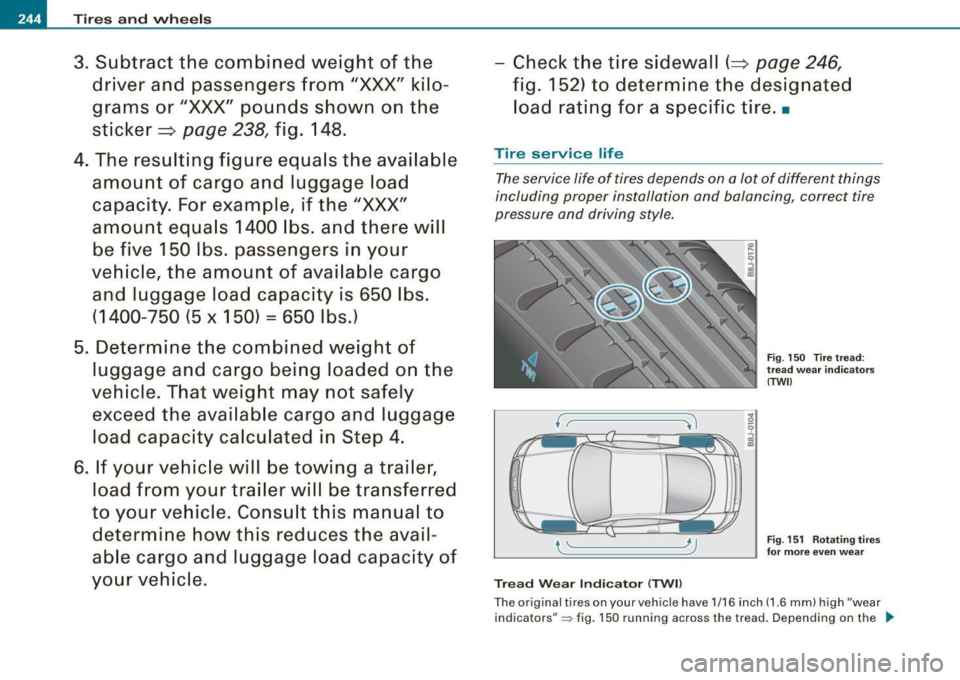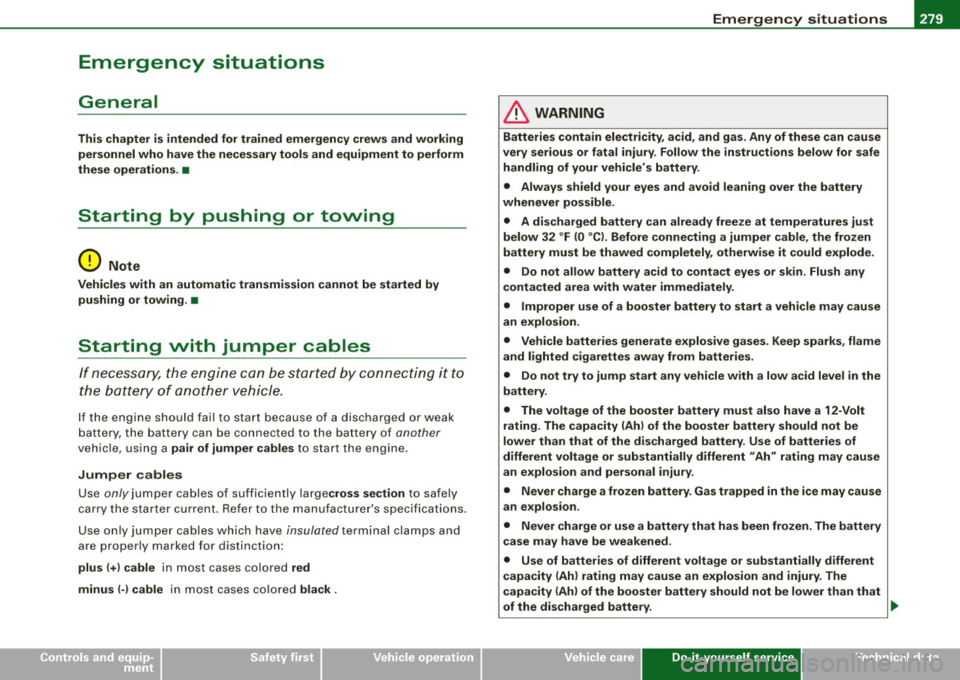towing capacity AUDI TT COUPE 2009 Owners Manual
[x] Cancel search | Manufacturer: AUDI, Model Year: 2009, Model line: TT COUPE, Model: AUDI TT COUPE 2009Pages: 316, PDF Size: 71.16 MB
Page 246 of 316

-Tires and wheels
3. Subtract the combined weight of the
driver and passengers from
"XXX" kilo
grams or
"XXX" pounds shown on the
sticker=>
page 238, fig. 148.
4. The resulting figure equals the available
amount of cargo and luggage load capacity. For example, if the
"XXX"
amount equals 1400 lbs. and there will
be five 150 lbs. passengers in your
vehicle, the amount of available cargo and luggage load capacity is 650 lbs. ( 1400- 750 (5
x 150) = 650 I bs.)
5. Determine the combined weight of luggage and cargo being loaded on the
vehicle. That weight may not safely exceed the available cargo and luggage load capacity calculated in Step 4.
6. If your vehicle will be towing a trailer, load from your trailer will be transferred
to your vehicle. Consult this manual to determine how this reduces the avail
able cargo and luggage load capacity of
your vehicle. -
Check the tire sidewall (=>
page 246,
fig. 152) to determine the designated
load rating for a specific tire . •
Tire service life
The service life of tires depends on a lot of different things
including proper installation and balancing, correct tire
pressure and driving style.
Fig. 150 Tire tread:
tread wear indicators
..__-lo..,.__,._~~--' (TWII
{ ------;g
0
r~~~~~~~~
• Fig. 151 Rotating tires
L_ __ ....::\ ;;~~~~~~~~~~~::::_ __ _J for more even wear
Tread Wear Indicator (TWll
The original tires on your vehicle have 1 /16 inch (1.6 mm) high "wear
indicators" ~ fig. 150 running across the tread. Depending on the
ai,.
Page 281 of 316

________________________________________________ E_m _ e_r..:: g ~ e_ n_c__, y:._ s_ i_ t ..:u ;..:a:.:. t.:.. i..: o :..; n..:..:: s __ ffllll
•
Emergency situations
General
This chapter is intended for trained emergency crews and working
pe rsonnel who have the necessary tools and equ ipment to perform
these operations. •
Starting by pushing or towing
(D Note
Vehicles with an automatic transmis sion cannot be started by
push ing or towing . •
Starting with jumper cables
If necess ary, the en gine can b e sta rted by co nnectin g it to
the battery of anothe r vehicle.
If th e engine should fail to start because of a discharged or weak
b at te ry, the batt ery ca n be co nnected t o the ba ttery of
another
vehicle, using a pair of jumper cables to start the engine .
Jumper cables
Use
only jumper cables of sufficiently large cross section to safe ly
c arry the s ta rt er cu rrent . Refer to the m anufac tu re r's sp ecifi cati ons.
Use only ju mper cables which have
insulated term ina l c lamps and
are proper ly marked for distinction:
plus (+l cable in mo st c ases co lor ed red
minus
(- 1 cable in most cas es color ed black .
& WARNING
Batteries contain electricity, acid , and gas. Any of the se can cause
very ser ious or fatal injury . Follow the instructions below for safe
handling of your vehicle 's battery .
• Always shield your eyes and avoid leaning over the battery
whenever possible .
• A discharged battery can already freeze at temperatures just
below 32 °F (0 °C l. Before connecting a jumper cable , the frozen
battery must be thawed completely , otherwise it could explode .
• Do not allow battery acid to conta ct eyes or skin. Flush any
contacted area with water immediately.
• Improper use of a booster battery to start a vehicle may cause
an explosion.
• Vehicle batteries generate e xplosive gases . Keep sparks , flame
and lighted c igarettes away from batteries.
• Do not try to jump st art any vehicle with a low acid level in the
battery.
• The voltage of the booster battery must also have a 12-Volt
rating. The capacity (Ah l of the booster battery should not be
lower than that of the discharged battery . Use of batteries of
different voltage or substantially different "Ah" rating may cause
an explosion and personal injury .
• Never charge a frozen battery. Gas trapped in the ice may cause
an explosion.
• Never charge or use a battery that has been frozen . The battery
c ase may have be weakened .
• Use of batter ies of different voltage or substantially different
c apacity (Ah l rating may cause an explosion and injury . The
capacity (Ahl of the booster batte ry should not be lower than that
of the discharged battery . _..
Do-it -yourself service